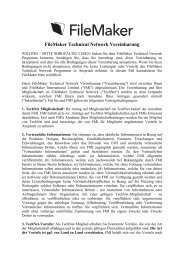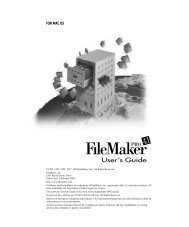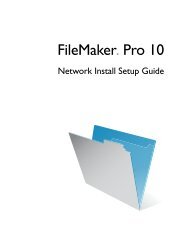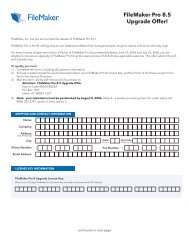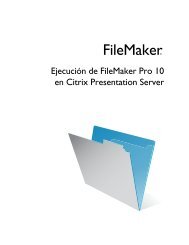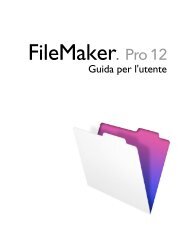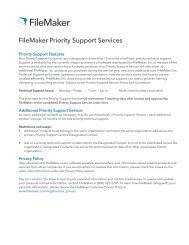FileMaker Security Guide
FileMaker Security Guide
FileMaker Security Guide
You also want an ePaper? Increase the reach of your titles
YUMPU automatically turns print PDFs into web optimized ePapers that Google loves.
• How damaging would its loss or disclosure be?<br />
• What is the minimum level of security to prevent loss or disclosure?<br />
• What tools can I use to implement that security?<br />
<strong>Security</strong> “Top 10” list 15<br />
To assess security, enable log files in <strong>FileMaker</strong> Pro and <strong>FileMaker</strong> Server and review users’<br />
actions. You can also track actions if you include scripts and calculations that capture the user’s<br />
account name, password, and IP address.<br />
10. Upgrade to <strong>FileMaker</strong> Pro 8 and <strong>FileMaker</strong> Server 8<br />
for security enhancements<br />
<strong>Security</strong> was redesigned in <strong>FileMaker</strong> Pro 7 and <strong>FileMaker</strong> Server 7. If you are upgrading from a<br />
pre-7.0 version, use the new security model for a more robust and streamlined user experience when<br />
assigning accounts and privilege sets.<br />
<strong>Security</strong> enhancements in <strong>FileMaker</strong> Pro<br />
• The security model is more intuitive, and functions similarly to other tools. You can create user<br />
accounts and passwords, and share privilege sets for multiple users and tables.<br />
• Because <strong>FileMaker</strong> Pro supports multiple tables within a file, you can protect a single-file, multitable<br />
database with one set of accounts and privilege sets.<br />
• You can use the Get(AccountName) function to determine the current user in functions and<br />
scripts. This opens many possibilities, such as creating scripts that can only be run by particular<br />
account names.<br />
• You can require users to specify a new password when they next open the database, and enable<br />
settings that require users to change their passwords after a specified number of days.<br />
• You can set a minimum character length for passwords.<br />
• With <strong>FileMaker</strong> networking, account names and passwords use a one-way encryption algorithm<br />
that prevents them from being deciphered by password-cracking tools. User account names and<br />
passwords are verified on the host computer, preventing hacking attempts on the client computer,<br />
or attempts to crack passwords with the executable or temp files. You must store your account<br />
name and password in a safe location. If you lose the account name and password, you will have<br />
to re-create the files.<br />
<strong>Security</strong> enhancements in <strong>FileMaker</strong> Server<br />
When you host databases with <strong>FileMaker</strong> Server, you can take advantage of a number of features<br />
that make your data more secure for both <strong>FileMaker</strong> Pro and web-based clients. For information on<br />
specific features, see the <strong>FileMaker</strong> Server Advanced Web Publishing Installation <strong>Guide</strong>, or the<br />
<strong>FileMaker</strong> Server Administrator's <strong>Guide</strong>.<br />
• To encrypt the user account information and the data with <strong>FileMaker</strong> networking, enable Secure<br />
connections to <strong>FileMaker</strong> Server.<br />
• If you’re sharing files to web-based clients, enable SSL encryption in a web server application<br />
to encrypt data that is passed from the host to guest computers on the web. For more information,<br />
see “Using Secure Sockets Layer (SSL) security for web publishing” on page 23.



